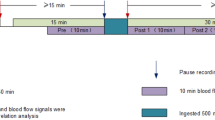Summary
The aim of the present study was to examine the circadian variation in skin blood flow and its relationship to the rhythm of rectal temperature. Eight young men were confined to continuous bed rest for 24 h in a thermoneutral environment. Rectal temperature, oxygen consumption, and peripheral blood flow (laser-Doppler flowmetry and plethysmography) were measured at intervals of 2 h, except at 2400 hours and 0600 hours. According to the cosinor-method, the mean rectal temperature displayed a statistically significant circadian variation with a minimum at 0400 hours. A significant circadian rhythm was also observed in total finger blood flow, finger laser-Doppler flow, and forearm laser-Doppler flow, but not in total forearm blood flow and forehead laser-Doppler flow. The rhythms of rectal temperature and extremity skin blood flow were phased differently, i.e. the decrease in rectal temperature was preceded by an increase in extremity skin blood flow with an average of 4-h time difference. The results would support the idea that circadian rhythm of core temperature is, at least in part, regulated by variation in extremity skin blood flow.
Similar content being viewed by others
References
Äikäs E, Karvonen MJ, Piironen P, Ruosteenoja R (1962) Intramuuscular, rectal an oesophageal temperature during exercise. Acta Physiol Scand 54:366–370
Aschoff J, Heise A (1972) Thermal conductance in man: its dependence on time of day and on ambient temperature. In: Itoh S et al (eds) Advances in climatic physiology. Igaku Shoin, Tokyo, pp 334–348
Aschoff J, Biebach H, Heise A, Schmidt T (1974) Day-night variation in heat balance. In: Monteith JL, Mount LE (eds) Heat loss from animals and man. Butterworth, London, pp 147–172
Bloch M (1964) Rhythmic diurnal variation in limb blood flow in man. Nature 202:398–399
Burton AC (1939) The range and variability of the blood flow in the human fingers and the vasomotor regulation of body temperature. Am J Physiol 127:437–453
Ewing DJ, Clarke BF (1982) Diagnosis and management of diabetic autonomic neuropathy. BMJ 285:916–918
Johnson JM, Taylor WF, Shepherd AP, Park MK (1984) Laser-Doppler measurement of skin blood flow: comparison with plethysmography. J Appl Physiol 56:798–803
Kofranyi E, Michaelis EF (1941) Ein tragbarer Apparat zur Bestimmung des Gasstoffwechsels. Arbeitsphysiologie 11:148–150
Mills JN, Minors DS, Waterhouse JM (1978) Adaptation to abrupt time shifts of the oscillator(s) controlling human circadian rhythms. J Physiol (Lond) 285:455–470
Minors DS, Waterhouse JM (1981) Circadian rhythms and the human. Wright, Bristol
Minors DS, Waterhouse JM (1984) The use of constant routines in unmasking the endogenous component of human circadian rhythms. Chronobiol Int 1:205–216
Nelson W, Tong TL, Lee JK, Halberg F (1979) Methods for cosinor-rhythmometry. Chronobiologia 6:305–323
Nilsson GE, Tenland T, Öberg PA (1980) Evaluation of a laser Doppler flowmeter for measurement of tissue blood flow. IEEE Trans Biomed Eng 27:597–604
Prinz PN, Halter J, Benedetti C, Raskind M (1979) Circadian variation of plasma catecholamines in young and old men: relation to rapid eye movement and slow wave sleep. J Clin Endocrinol Metab 49:300–304
Rowell LB (1983) Cardiovascular adjustments to thermal stress. In: Handbook of physiology. The cardiovascular system. Peripheral circulation and organ blood flow, section 2, vol. III, part 2, chapter 27. American Physiological Society, Bethesda, Md., pp 967–1023
Shepherd JT, Vanhoutte PM (1979) The human cardiovascular system. Facts and concepts. Raven Press, New York
Smith REL (1969) Circadian variations in human thermoregulatory responses. J Appl Physiol 26:554–560
Smolander JK, Kolari P (1985) Laser-Doppler and plethysmographic skin blood flow during exercise and during acute heat stress in the sauna. Eur J Appl Physiol 54:371–377
Webb P (1971) Metabolic heat balance data for 24-hour periods. Int J Biometeorol 15:151–155
Whitney RJ (1953) The measurement of volume changes in human limbs. J Physiol (Lond) 121:1–27
Author information
Authors and Affiliations
Rights and permissions
About this article
Cite this article
Smolander, J., Härmä, M., Lindgvist, A. et al. Circadian variation in peripheral blood flow in relation to core temperature at rest. Europ. J. Appl. Physiol. 67, 192–196 (1993). https://doi.org/10.1007/BF00376666
Accepted:
Issue Date:
DOI: https://doi.org/10.1007/BF00376666




